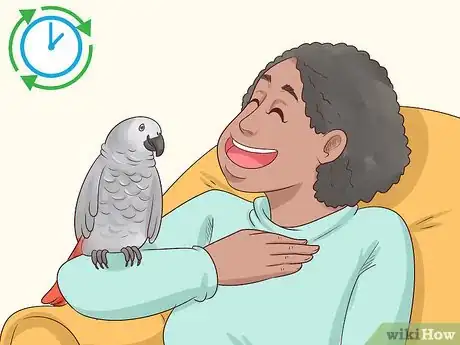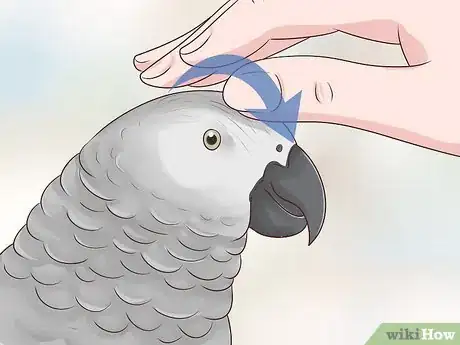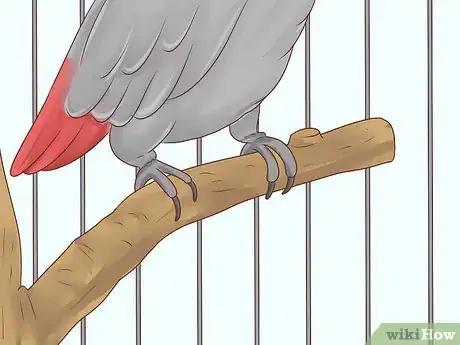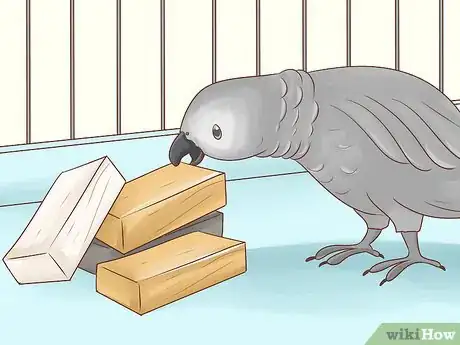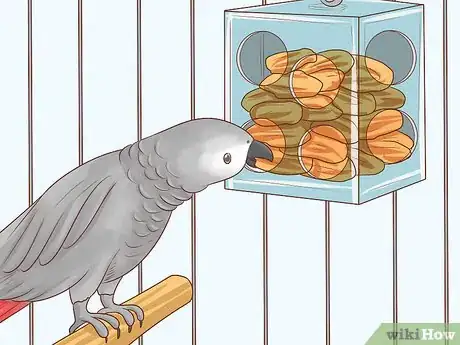This article was co-authored by Pippa Elliott, MRCVS. Dr. Elliott, BVMS, MRCVS is a veterinarian with over 30 years of experience in veterinary surgery and companion animal practice. She graduated from the University of Glasgow in 1987 with a degree in veterinary medicine and surgery. She has worked at the same animal clinic in her hometown for over 20 years.
There are 10 references cited in this article, which can be found at the bottom of the page.
wikiHow marks an article as reader-approved once it receives enough positive feedback. In this case, 98% of readers who voted found the article helpful, earning it our reader-approved status.
This article has been viewed 40,340 times.
African Grey Parrots are highly intelligent animals that require social interaction and a stimulating environment. Your pet will love spending lots of quality time talking and playing with you, so try teaching it to talk or training it to do basic tricks. Enriching its habitat will improve its quality of life, so offer a mix of perches, and hide treats throughout its enclosure. Puzzles and chewable objects are great sources of entertainment, so provide your African Grey with a steady rotation of store-bought and homemade toys.
Steps
Spending Quality Time with Your Parrot
-
1Spend lots of time with your parrot. African Greys are social, intelligent, and emotional animals, so you’ll need to spend lots of time with your pet. Talking, dancing, training, and playing with your parrot every day will help meet its needs. Just sitting in the same room can offer the social interaction it needs.[1]
- Try not to leave your parrot alone for extended periods during the first year of its life. When you eventually do go out of town, have someone your parrot has already spent lots of time with house-sit or keep the bird at their home.
-
2Stroke the feathers on its head toward its beak. Parrots enjoy being pet on the head, where itchy new feathers grow that it can’t reach. Scratch gently from the top of its head toward its beak to deepen your relationship with your pet.
- Make sure your parrot enjoys being stroked. Look for signs like fluffing its head feathers in excitement when you’re about to pet it. If it trembles, squats, or pants, it probably doesn’t like being touched.
- Petting from head to tail is typically either uncomfortable or interpreted as a mating behavior, so scratching is best kept to the head.
Advertisement -
3Try teaching your parrot to talk. African Greys are among the best-known talkers, and most have an easy time learning to mimic words. Start with simple words, like “hello” or “bird,” and repeat them over and over in front of your parrot. Speak clearly, have patience, and offer treats and plenty of praise when it finally does say a word.[2]
-
4Train your parrot. In addition to teaching it to talk, basic training can help strengthen your bond and provide your pet with mental stimulation. Start with easy positive reinforcement. Give it lots of praise when you see it performing a desirable behavior, such as eating or playing with its toys.[3]
- Then try teaching it basic tricks. Hold your arm in front of it like a perch, then say, “Step up!” When it hops onto your arm, give it a treat. Use the same technique to teach it a step-down command.
- You can also try clicker training your bird so it associates the sound of a clicker with good behavior and a reward.
Enriching Its Environment
-
1Make its enclosure as large as possible. A three feet by two feet by four feet (0.9 meter by 0.6 meter by 1.2 meters) cage is the minimum recommended size for an African Grey.[4] However, bigger is better, so provide it with the largest enclosure you can accommodate.[5]
- Some Grey owners even use small spare rooms as enclosures for their pets.
-
2Hide treats to encourage it to forage. In its natural environment, an African Grey would spend time foraging for food. In addition to providing it with food bowls, hide treats throughout your bird’s habitat to keep it entertained.[6]
- Try hiding seeds or a favorite treat in a container of pebbles. Wrap food bowls in cardboard or paper so your bird has to dig to get its food. You can also find food-dispensing puzzle toys for parrots online or at pet stores.
- You can also get your bird a foraging feeder that's designed to replicate how it would forage for food in the wild.[7]
-
3Mimic natural features instead of using straight perches. Simple dowel perches with ninety-degree angles can get boring. Instead, provide a variety of perches that mimic branches and other natural features.[8]
-
4Keep nontoxic plants in your parrot’s enclosure. Plants that are safe for birds can also enrich your African Grey’s environment. Any plants you place in the enclosure should be free of pesticides and other chemicals.[11]
- For example, spider plants and bamboo are bird safe and easy to grow. Kale is an attractive choice and can provide your parrot with nutrients.
- You can find extensive lists of safe and harmful plants online.[12]
Providing It with Toys
-
1Give your parrot toys it can chew and destroy. Parrots instinctively like to chew and destroy wood. Wood scraps, paper, cardboard, and store-bought chew toys will help keep your African Grey entertained.[13]
- An old woven wood basket from a thrift store can also provide an inexpensive parrot toy.
-
2Provide it with puzzle toys. Look online or at your pet store for puzzle toys that dispense food, have moving parts, or make noise. In addition to encouraging your bird to forage, they’ll provide it with mental stimulation.[14]
- Make sure any store-bought or homemade toys don’t have small, hard parts that can come off and pose a choking risk.
-
3Make your own parrot toys. Try stacking decorative woven balls, pieces of egg cartons, and wood scraps on a stainless steel skewer. As a bonus, hide bits of fruits and vegetables throughout your makeshift toy.[15]
- Other good homemade toy components include wads of newspaper or cardboard, large wooden popsicle sticks, and large buttons.[16]
-
4Rotate toys to keep your parrot stimulated. Every week or two, swap toys out with new ones or others from your parrot’s collection. Rotating toys will help prevent your parrot from getting bored with them.[17]
- When introducing a new toy, play with your parrot and show it how to use the new toy. That way, it won’t shy away from the new object.[18]
References
- ↑ http://www.veterinarypartner.com/Content.plx?P=A&A=2996&S=0&EVetID=0
- ↑ http://www.vetstreet.com/our-pet-experts/10-tips-to-help-teach-your-parrot-to-talk
- ↑ http://www.veterinarypartner.com/Content.plx?P=A&A=2996&S=0&EVetID=0
- ↑ http://www.caminoanimalclinic.com/veterinary-topics/choosing-pet/birds/african-grey-parrots/
- ↑ http://understandingparrots.com/test/#more-9
- ↑ http://www.veterinarypartner.com/Content.plx?P=A&A=2996&S=0&EVetID=0
- ↑ https://www.bird-cage.com/foraging-toys/
- ↑ http://understandingparrots.com/test/#more-9
- ↑ http://www.parrotenrichment.com/perches---playstands.html
- ↑ http://www.caminoanimalclinic.com/veterinary-topics/choosing-pet/birds/african-grey-parrots/
- ↑ http://nebula.wsimg.com/436f5a9956b227946a6ed81633622973?AccessKeyId=82DA67762E035B563F83&disposition=0&alloworigin=1
- ↑ http://www.peteducation.com/article.cfm?c=15+1912&aid=2236
- ↑ http://www.african-grey-parrot.com/African-Grey-Toys.aspx
- ↑ http://www.veterinarypartner.com/Content.plx?P=A&A=2996&S=0&EVetID=0
- ↑ http://understandingparrots.com/stainless-steel-skewer-toy-bases/#more-78
- ↑ http://www.african-grey-parrot.com/African-Grey-Toys.aspx
- ↑ http://www.caminoanimalclinic.com/veterinary-topics/choosing-pet/birds/african-grey-parrots/
- ↑ http://www.african-grey-parrot.com/African-Grey-Toys.aspx
About This Article
If you want to entertain an African grey parrot, you can simply give it a gentle scratch on the itchy spot from the top of its head to its beak. Also, exercise its mind by hiding treats in your bird’s habitat. For example, try hiding seeds in a container of pebbles or wrap a food bowl in paper so it has to dig and forage like it would in the wild. For more fun, give your parrot a scrap of wood or an old woven wooden basket that will let it give in to its instinctual desire to chew and destroy wood. For more tips from our Veterinary co-author, including how to teach your parrot to talk, read on!
